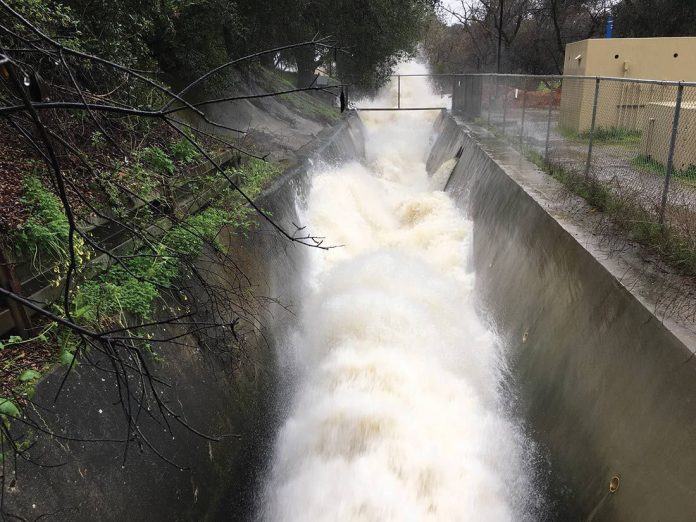With the approach of winter harkening memories of devastating floods downstream from Anderson Reservoir’s northeast Morgan Hill spillway, officials have assured locals that precautions are underway to minimize the risks that became reality earlier this year.
Santa Clara Valley Water District staff visited the Morgan Hill City Council Nov. 15 to provide an update of the Anderson Dam seismic retrofit project, construction of which is scheduled to start in 2020 and continue until 2025.
During that discussion, city officials also wanted to know about the district’s plans for operating Anderson, the county’s largest reservoir, this coming winter.
During a series of heavy storms in February 2017, Anderson Reservoir filled beyond capacity. Water gushed over the dam’s spillway into Coyote Creek, flooding thousands of people out of their homes downstream in San Jose, and resulting in about $100 million worth of damage.
The water district, which owns and operates Anderson Reservoir and the dam facilities, and City of San Jose were criticized for failing to prepare for the damage or warn downstream residents about the approaching calamity.
For this winter, the SCVWD board of directors decided to operate Anderson and Coyote Reservoirs—the latter of which is upstream from Anderson—under what Deputy Operating Officer Katherine Oven referred to as the “40 percent exceedance rule.” That means they will keep the two water bodies’ combined levels low enough that there will be less than a 40 percent chance of the water reaching the seismic restriction levels set by state and federal regulators for both Anderson and Coyote.
Since 2009, these regulations have limited Anderson to no more than 68 percent of its 90,373-acre-feet of total capacity. While the water district is required to release water from the bottom of the dam into Coyote Creek when Anderson exceeds that limit, during prolonged heavy rains—such as occurred in January and February—the reservoir can fill up faster than the water can be released.
That is how neighborhoods in San Jose became flooded during President’s Day weekend.
Anderson Reservoir is currently about 34 percent full, according to the SCVWD website. Coyote is about 19.5 percent full.
On Oct. 10, the SCVWD board of directors voted to operate Anderson at an even lower level than in recent years, “which will reduce the risk of flooding downstream,” said water district board chair John Varela, who represents the area that includes Morgan Hill.
Water officials have argued that Anderson is crucial for storage of the county’s drinking water supplies, and lowering it too much could limit those supplies. But they don’t think that will be an issue this winter.
“The improved water supply resulting from last winter’s above-average precipitation will allow us to operate the reservoir at lower levels than in past years while meeting water supply needs of the county,” Varela said.
He added that last week, the district increased the release of water out of Anderson—despite its already low level—in order to meet the 40-percent risk reduction curve.
Varela also noted, “Flooding cannot be 100 percent prevented,” but these precautions will “significantly reduce” the risk.
Officials won’t know how severe this winter’s rains will be until January or February, Oven told the council Nov. 15.
Construction process
Construction on the $400-million Anderson Dam seismic upgrade project will begin in 2020 with “dewatering” the reservoir or emptying it of water, Oven told the council. This will take up to 20 months to complete.
After that, construction and earth moving crews will work during the summer months to remove the existing outer shells of the dam. The goal is to eliminate any material within the dam that regulators have determined could liquefy in the event of a major earthquake on a fault that passes near the dam.
After that, the crews will strengthen the “core” of the dam, and rebuild the outer layers with stronger earthen materials, Oven explained. The crest of the dam will be built up higher than its current elevation of 647 feet.
Construction will only occur during the dry months of the late spring and summer through 2025. Cochrane Road under the dam will be closed to vehicle traffic except for neighborhood residents when construction is taking place. The county park in that area will be closed as well.
The project also includes upgrades to the emergency spillway to increase its outflow capacity; a new “high level” outlet pipe; and a “low level” outlet pipe that is significantly wider than the existing outlet.
In 2009, the California Division of Safety of Dams determined Anderson Reservoir needed a new dam because the current structure’s foundation contains sand and gravel that could liquefy in a big quake. Specifically, the dam could turn to liquid if a quake of 6.6 magnitude or higher is registered on the Calaveras fault directly beneath the lake, or a 7.2 quake occurs within a mile or two on the same fault.
In such an event, the top of the dam could slump and allow water to spill over, the 2009 study says, potentially sending a 35-foot wall of water rushing to downtown Morgan Hill, flooding Gilroy, San Martin and the entire valley floor up to San Jose within hours.








